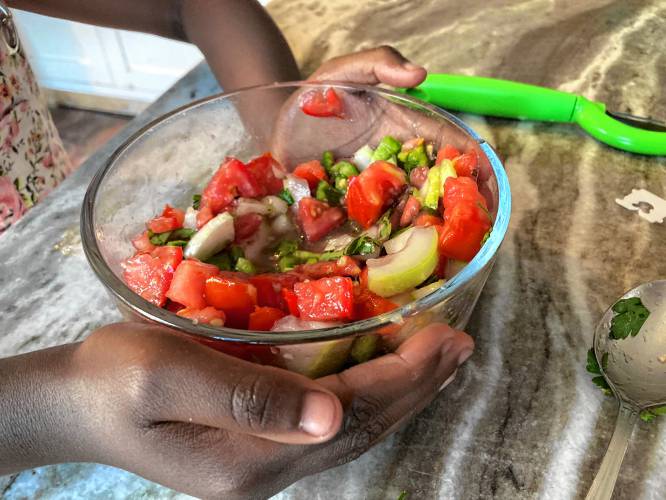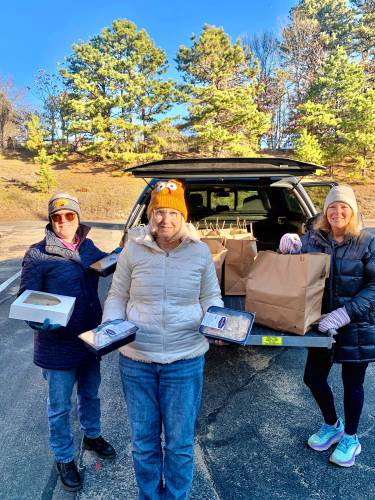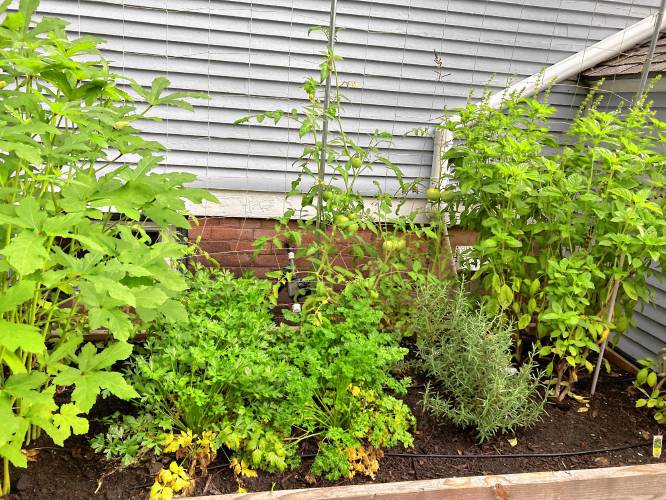Rescuing food and feeding people: Rachel’s Table programs continue to expand throughout western Mass
|
Published: 04-23-2024 12:46 PM
Modified: 04-23-2024 2:37 PM |
My great-grandmother’s oak dining table has graced my kitchen ever since my parents built the house in the 1980s. Looking at it makes me happy. The table — actually, almost any table — signifies history, nourishment, family and community.
The figurative Rachel’s Table of Western Massachusetts represents those things as well. It was founded in 1992 as part of the Jewish Federation of Western Massachusetts. Appropriately for its name, the group was started in Springfield by strong women in that federation, Executive Director Jodi Falk told me in a recent interview.
“They saw that there was so much hunger,” said Falk. “One of them was the owner of a restaurant … There was food going to waste, and there were hungry people. It was crazy that you would have hungry people and surplus food.”
The group started by finding volunteers to perform what the group calls food rescue — picking up surplus food from restaurants and small bakeries and getting it to people who could use it. Over the years, it expanded its mission to include purchasing food and performing what it calls “gleaning,” recovering leftover food from farms and orchards. It also initiated education programs and started helping people learn to raise their own food.
Rachel’s Table expanded geographically as well. It began in one city. Today it works in Hampden, Hampshire and Franklin Counties, and it occasionally strays into Berkshire County and over the border into Connecticut.
Last summer, the group split off from the Federation to become its own nonprofit identity. “We got too big,” explained Falk. “The amount of work that we’re doing, the time needed from staff to do our work … The folks that we serve are different.”
The people with whom the group works include a variety of religious and non-religious groups, from the Food Bank of Western Massachusetts to the Y.M.C.A. in Greenfield.
Still, Falk noted, “We are based in Jewish values. We don’t shy away from that. They’re humanitarian values.”
Article continues after...
Yesterday's Most Read Articles
 Orange Selectboard declares armory as surplus property
Orange Selectboard declares armory as surplus property
 DA to announce breakthrough in 1989 unsolved homicide
DA to announce breakthrough in 1989 unsolved homicide
 1989 homicide victim found in Warwick ID’d through genetic testing, but some mysteries remain
1989 homicide victim found in Warwick ID’d through genetic testing, but some mysteries remain
 Sportsman’s Corner: Orange Gun Club’s Kids Derby
Sportsman’s Corner: Orange Gun Club’s Kids Derby
 Carol Doucette of Royalston receives $15,000 from Publishers Clearing House
Carol Doucette of Royalston receives $15,000 from Publishers Clearing House
 Michelle Caruso: Questions candidate’s judgment after 1980s police training incident
Michelle Caruso: Questions candidate’s judgment after 1980s police training incident
To give me a sense of those values and to help me learn more about the work of Rachel’s Table, Falk introduced me to her colleague Cara Michelle Silverberg. Silverberg, who has a background in education, was brought in to coordinate the gleaning program.
She also works with Rachel’s Table’s student interns (one from Smith College, one from Greenfield Community College), looks for grants, and works on the Growing Gardens program. That program helps families select and raise some of the foods they want to consume.
Like many nonprofit organizations, Rachel’s Table began by relying on older volunteers. Over the years, however, it has expanded its outreach to include young people as well. It involves families in the gleaning program, and it has instituted a teen board to advocate for food justice and educate other young people about food insecurity.
Silverberg has a special fondness both for the garden program and the gleaning program.
“I love having my hands in the earth,” she said with a smile. “I love being outside with people, helping them connect with the land in a way that is empowering and healthy and fulfilling … I just find it delightful.”
Silverberg shared with me a children’s cookbook developed by one of Rachel’s Table’s community partners, Christina’s House in Springfield. Christina’s House offers transitional housing and education to women and their children in need. Its residents are involved in the Growing Gardens project and, according to Silverberg, obtain both satisfaction and nutrition out of raising food together.
“They’ve been such a pleasure to work with,” she said of the residents with whom she has worked. “One of their winter projects was the cookbook.”
The book has stories about food written by several children as well as recipes that use the produce from their garden. The recipes include smoothies, kale pesto, buffalo cauliflower, and more. The book also features pictures the children created of a variety of plants.
I’m sharing a simple salad here. I can’t wait to have the fresh produce in hand to make it.
Eating it will remind me not just of Christina’s House but also of Rachel’s Table, which has expanded its activities enormously since breaking off as its own nonprofit.
“I kept waiting for the day when I could just coast,” Falk said. It doesn’t look as though that day is coming anytime soon, she noted. Silverberg concurred, saying, “Unfortunately, yes, the need is there. We go in there to meet the need, and the need keeps growing.”
Rachel’s Table is always looking for volunteers. For more information, visit https://feedwma.org/.
from “Christina’s House Cooks!”
Ingredients:
1 pint cherry tomatoes plus 2 or 3 heirloom tomatoes, cut up
1 large cucumber, peeled and cut into bite-size pieces
2 tablespoons apple-cider vinegar
1 tablespoon olive oil
1 teaspoon Italian seasoning
1 pint mozzarella balls
Instructions:
Mix all the ingredients together, and let them sit for an hour before serving. “Yummy,” says the cookbook.
Tinky Weisblat is an award-winning cookbook author and singer known as the Diva of Deliciousness. Visit her website, TinkyCooks.com.




